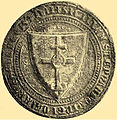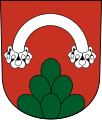Mount (heraldry)
In heraldry, a mount (also mountain, hill, hillock) is a representation of a hill or mountain as a curved terrace in base.[1] When the mount is included in the lower part of the shield, it may be considered an ordinary rather than a charge.
A trimount, also described as a mount mounted, or shapournet shapourned, is a representation of a mount with three tops.[2] For mounts with more than three tops, the number of tops is blazoned as coupeaux (e.g. a mount with six coupeaux).
The trimount (in German, Dreiberg) can be found in all heraldic traditions (Gallo-British, German-Nordic and Latin), but it is especially common in Switzerland.[3]
A design of six hills (Sechsberg) can also be found in Swiss and Italian heraldry. In medieval German heraldry, mounts could have ten or more tops.[4] Mounts with more than three tops are blazoned as a mount of N coupeaux, e.g. German Sechsberg would be a mount of six coupeaux, German Zehnberg as a mount of ten coupeaux.[3] A mount with more than six tops can also be blazoned as Schroffen in German heraldry.
Terrace in base curved[edit]
A terrace in base curved is blazoned mount, hill or hillock when represented in vert; sometimes as a mount vert for clarity. Sometines, a terrace in base curved may be blazoned as mount even when not tinctured vert. This is mostly found in cases where the base represents a hill for one or several of the charges in the coat of arms. Classification either as an ordinary or, in many cases, as a charge, is a matter of interpretation.
-
Altafulla (Or, a mount gules surmounted by a leaf vert)
Double mount[edit]
Trimount[edit]
The coats of arms of Hungary and Slovakia depict a trimount with a double cross, first used in the seal of Stephen V of Hungary (r. 1270–1272). At first, it was only a small element at the bottom of the coat of arms, later it became regular heraldic figure. Originally it represented biblical Golgota.[5][6][7] Modern day Slovak interpretation is that it represents three mountain ranges of the Kingdom of Hungary: the Tatra, Fatra, and Mátra.[8][9][10]
-
Seal of Stephen V of Hungary (c. 1270), coat of arms of Hungary
-
Seal of Wenceslaus III of Bohemia (c. 1301), coat of arms of Slovakia
The representation of three pointed mountains (not a heraldic trimount) in the 1991 coat of arms of Slovenia symbolises Triglav, the highest mountain in Slovenia.
Mount of four coupeaux[edit]
-
Helfenstein (Zurich armorial)
Mount of five coupeaux[edit]
-
Freundsberg (Frontsperg, Frundsberg), 16th century
Mount of six coupeaux[edit]
-
Grünenberg (15th century)
-
Freundsberg (Fronsberg, Frundsberg)
Mount of ten coupeaux[edit]
-
Grünenberg (Zürich armorial)
Mount of twelve coupeaux[edit]
References[edit]
- ^ "Armorial Gold Heraldry Symbolism Library". Armorial Gold. Retrieved 30 June 2013.
- ^ "Mount" in: William Berry, Encyclopaedia Heraldica, Or Complete Dictionary of Heraldry (1828).
- ^ a b The Coat of Arms, Volume 3, Issue 17, Heraldry Society, 1966, 36f.
- ^ Seals of the Salenstein coat of arms show a mount of twelve tops in 1264, and even one with twenty-eight in 1297.
Ernst Herdi: Die Schenken und die Dienstmannen von Salenstein In: Thurgauische Beiträge zur vaterländischen Geschichte. Vol. 79. Year: 1943. pp 47 ff. - ^ "Štátny znak Slovenskej republiky".
- ^ "Byzantské korene štátneho znaku SR". 13 September 2019.
- ^ "Ako vznikal štátny znak. Pozrite si doteraz skryté socialistické návrhy".
- ^ "Úrad vlády Slovenskej republiky / Štátny znak".
- ^ Betsy Dru Tecco: How to Draw Hungary's Sights and Symbols, The Rosen Publishing Group, New York, 2005 [1]
- ^ "Ako vznikal štátny znak. Pozrite si doteraz skryté socialistické návrhy".




























